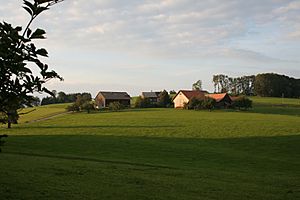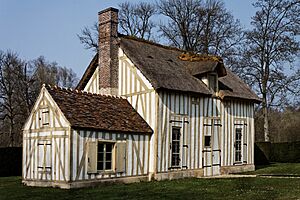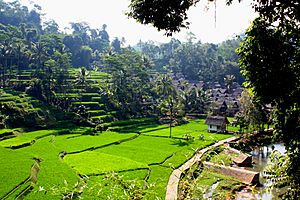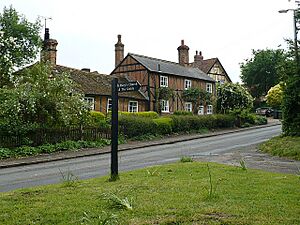Hamlet (place) facts for kids
A hamlet is a human settlement that is smaller than a town or village. It is often just an informal way to describe a very small community. Sometimes, a hamlet is officially recognized for government or administrative reasons.
The idea of a hamlet comes from Norman England. The Old French word hamelet was used for these tiny settlements.
Contents
What Does "Hamlet" Mean?
The word "hamlet" comes from the Anglo-Norman word hamelet. This word is a smaller version of the Old French word hamel, which means "a little village."
Hamel itself might have come from West Germanic languages. It is similar to the modern French word hameau, the Dutch heem, the German Heim, and the English word home.
Hamlets Around the World
Afghanistan
In Afghanistan, a hamlet is called a qala (Dari: قلعه, Pashto: کلي). This word means "fort" or "hamlet." An Afghan qala is a group of fortified houses. It usually has its own community building, like a mosque, but no marketplace. A qala is the smallest type of settlement in Afghanistan. A village is larger and has a commercial area.
Canada
In Canada's three territories, hamlets are officially recognized municipalities.
- The Northwest Territories had 11 hamlets in 2010. Most had fewer than 900 people in 2016.
- Nunavut had 24 hamlets in 2010. Their populations ranged from 129 to 2,842 in 2016.
- Yukon had two hamlets in 2010. Both had fewer than 450 people in 2016.
In Canada's provinces, hamlets are usually small communities that are not officially separate towns. They are part of a larger municipality. For example, many communities in Ontario and Alberta are hamlets.
Canada's two largest hamlets are Fort McMurray and Sherwood Park in Alberta. Each has over 60,000 people. This is much more than the 10,000 people needed to become a city in Alberta. These two hamlets are called "urban service areas." This means they are treated like cities for government programs and funding.
France
In France, a hamlet is called a hameau. It is a group of houses in the countryside, too small to be a village. The term Lieu-dit can also mean a hamlet, but it can also refer to places where no one lives.
In the 1700s, rich people liked to build their own hameau in their gardens. These were groups of houses or farms that looked rustic but were very comfortable. Famous examples include the Hameau de la Reine built by Queen Marie-Antoinette at the Château de Versailles. Another is the Hameau de Chantilly built by Louis Joseph, Prince of Condé in Chantilly, Oise.
Germany
The German word for hamlet is Weiler. A Weiler does not have its own services like an inn, school, store, or church. This is different from a Dorf (village). The houses in a Weiler can be close together or spread out. In North West Germany, scattered farms are called Bauerschaft.
In a Weiler, houses are just numbered, there are no street names. There is no official legal definition for a hamlet in Germany. In Bavaria, a Weiler is a settlement with 3 to 9 houses. If it has 10 or more houses, it is called a village. A hamlet is usually part of a larger municipality.
India
In different parts of India, hamlets have different names.
- In Haryana and Rajasthan, it is called "dhani" or "Thok".
- In Gujarat, a hamlet is called a "nesada". These are common in the Gir forest.
- In Maharashtra, it is called a "pada".
- In southern Bihar, it is called a "bigha".
- In Karnataka, hamlets are known as Palya, Hadi, Keri, and Padi. In the past, hamlets had fewer people than villages. Today, many have grown into villages, towns, or cities.
Indonesia
Across Indonesia, hamlets are often called "small villages." They are known as desa or kampung.
- In Central Java and East Java, they are called dusun.
- In Bali, they are called banjar.
- In West Sumatra, they are called jorong or kampuang.
Netherlands
The Dutch words for hamlet are gehucht or buurtschap. Like in Germany, a Dutch hamlet does not have services like an inn, school, or store. It often has only one street with the same name as the hamlet. The houses can be spread out.
While similar, gehucht and buurtschap are not exactly the same. A gehucht is officially an independent place to live, like Wateren. A buurtschap is officially part of another place, like Bartlehiem which is part of Wyns.
Pakistan
In Pakistan, a hamlet is called a gaaon or mauza in Urdu. In Punjabi, it is giraaan or pind. In Pashto, it is kalay. These words are almost the same as "village."
Poland
In Poland, the law recognizes different types of rural settlements.
- A Przysiółek (which means "hamlet") is a group of farms.
- An Osada (meaning "settlement" or "hamlet") includes smaller settlements. These might be different because of their buildings or because people living there are connected to a specific place or job. Examples include mill settlements, forest settlements, or railway settlements. They can be independent or part of a village.
Romania
In Romania, hamlets are called cătune (singular: cătun). They are villages with only a few houses. Legally, they are considered villages and are grouped with them for statistics. Like villages, they do not have their own government. They are part of a larger commune.
Russia
In the Russian language, several words mean "a hamlet." The most common is derevnia. The words selo and posiolok are also often used. In the past, a selo usually had a church, while a derevnia did not.
The word khutor used to be common for the smallest rural settlement. It is similar to an English hamlet. However, it is not used much anymore. In the past, the government wanted all settlements to have basic services and a central authority. This is the opposite of a hamlet, which is too small for these things. If a nearby khutor got a shop, school, or community center, people would often move closer to it, forming a larger village.
Today, the word derevenka (meaning "tiny derevnia") is used informally. It describes settlements that have some village services but are still the size of a hamlet.
Spain
In Spain, a hamlet is called lugar, aldea, or cortijada. The word cortijada comes from cortijo, meaning "estate." In southern Spain, caserío is also used for small groups of rural homes or farmhouses.
A hamlet in Spain is a human settlement, usually in rural areas. It is typically smaller in size and population than a village (called pueblo in Spain). Hamlets are common in northwest Spain, like Asturias, Cantabria, and Galicia. They depend on a larger area, such as a parish or municipality.
In Spain, the hamlet is one of the official categories for population groups. In 1930, a rule defined an aldea (hamlet) as the smallest population group. It usually has fewer people and is more spread out than a lugar, though its buildings can also be on streets and squares.
Switzerland
In Switzerland's four national languages, hamlets are known as Weiler (German), hameaux (French), frazioni (Italian), and fracziun (Romansh). A hamlet is always part of a larger municipality. Sometimes, it might even be shared between two municipalities.
The main difference between a hamlet and a village is that a hamlet usually does not have a central core or a main building like a church or inn. However, some hamlets, called Kirchwiler, might have grown around a church. There is no set population size for a hamlet. Some hamlets are even larger than the smallest municipalities. Generally, hamlets do not have street names. Addresses are given by the hamlet name and a number.
A hamlet might have formed a Bürgergemeinde (a legal group of citizens). This group might own shared property for its members.
Turkey
In Turkey, a hamlet is called a mezra. It is a small satellite settlement, usually with a few houses, located on the rural edges of a village.
Ukraine
In Ukraine, a very small village or hamlet is usually called a selyshche or khutir. Other historical names for small settlements included volia, sloboda, huta, and buda.
United Kingdom
England
In England, a hamlet is simply a small settlement, perhaps with a few houses or farms. It is smaller than a village. Traditionally and legally, it meant a village or town without a church. However, hamlets are now recognized in land use planning policies.
Historically, a hamlet might be a secondary settlement in a civil parish, after the main village. For example, Chipping is a hamlet within the civil parish of Buckland. Hamlets might have formed around one main economic activity, like a farm, mill, mine, or harbor. Some hamlets are what is left after a village lost most of its people, like Graby and Shapwick. Because of the hilly land, the village of Clent has five separate hamlets.
Northern Ireland
In Northern Ireland, the Irish place name baile is sometimes thought to be like the English word "hamlet." However, baile actually referred to what is now called a townland. This is a geographical area, not just a small village.
Scotland
In the Scottish Highlands, the Gaelic word clachan is often used instead of "hamlet." In Scotland generally, ferm toun is used for a farm settlement. This includes farm buildings and homes for farm workers.
Wales
The term hamlet was used in Wales to describe a geographical part of a parish. These parts might or might not contain a settlement. In other places, like England, these parts were called "townships" or "tithings." The Welsh word for "hamlet" is pentrefan (or pentrefyn). Both words are smaller versions of pentref ("village"), meaning "small village."
United States
Mississippi
In Mississippi, a 2009 state law created the term "municipal historical hamlet." This term is for any former city, town, or village with fewer than 600 people that lost its official status before 1945. The first place to get this name was Bogue Chitto, Lincoln County.
New York
In New York, hamlets are communities that are not officially separate towns or villages. They are part of larger towns. Hamlets do not have their own local government or official borders. Their locations are often shown on road signs. Sometimes, a hamlet might have a specific service, like water or lighting, just for that area.
A hamlet can be thought of as the rural or suburban version of a neighborhood in a city or village. The exact area of a hamlet might not be clearly defined. It could be set by the Census Bureau or by a ZIP Code, school district, or fire district. Rural hamlets are often only marked by speed zones on their roads. Some hamlets, like Forestville, New York, are what is left of former villages. Some hamlets near cities, like Levittown in the Town of Hempstead, have over 50,000 people. This is more people than some official cities in the state.
Oregon
In Oregon, especially in Clackamas County, a hamlet is a type of local government for small communities. It allows people to organize and plan community activities. Hamlets do not provide services like utilities or fire protection. They also cannot collect taxes or fees. There are four hamlets in Oregon: Beavercreek, Mulino, Molalla Prairie, and Stafford.
Vietnam
In Vietnam, a hamlet (xóm, ấp) is the smallest unofficial administrative unit. It is a smaller part of a commune or township (xã).
See also
 In Spanish: Aldea para niños
In Spanish: Aldea para niños





